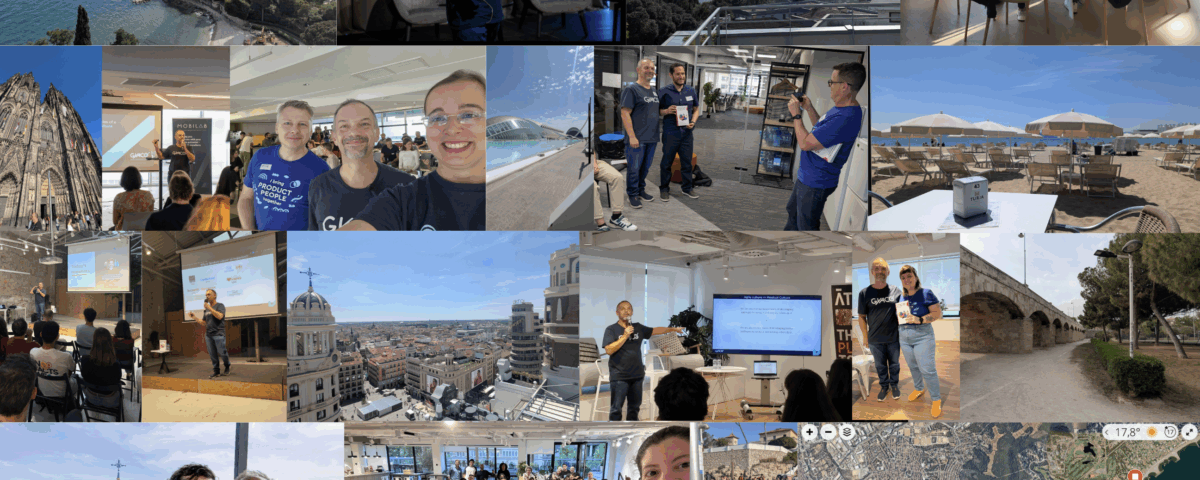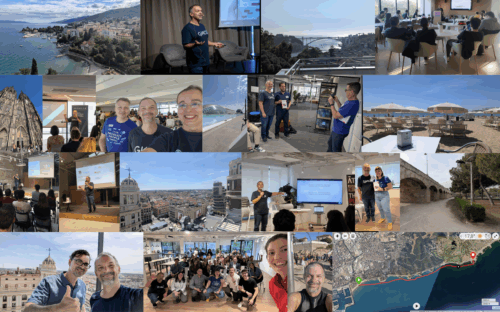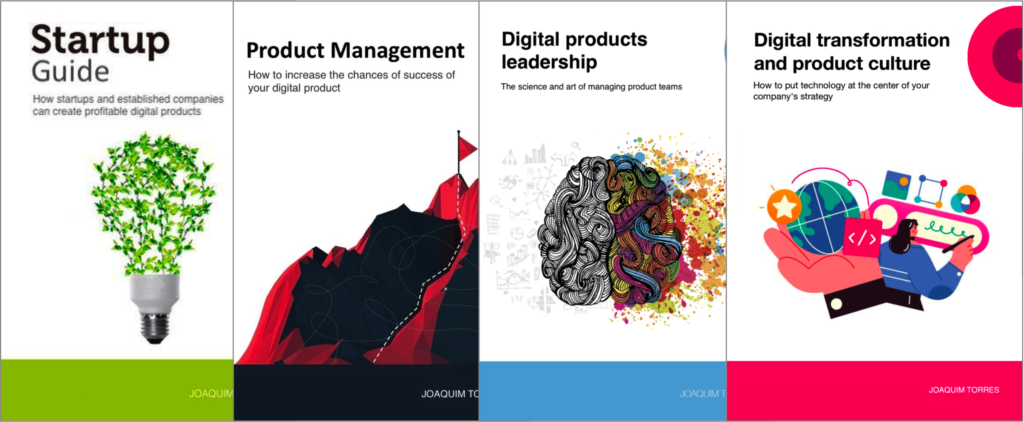
The Internet Sparked Excitement. AI Sparks Fear. Why?
20 de May, 2025
Discovery Misconception #4: Thinking that engineering should focus on delivery
3 de June, 2025I’m an introspective person. I prefer listening to speaking. I like to prepare carefully before I share my thoughts. So when I decided to go on a speaking tour across Europe with two main goals:
- to launch the English and Spanish editions of my latest book, Digital Transformation and Product Culture, and
- to (in)validate my hypothesis that the challenges in product development and management I’ve encountered throughout my career are universal
I knew I’d be stepping far out of my comfort zone. But it was absolutely worth it.
I visited six cities: Opatija in Croatia, Cologne in Germany, Porto in Portugal, and Valencia, Barcelona, and Madrid in Spain. In each place, I met dozens of product professionals at meetups, conferences, and hallway chats.
Each context had its own particularities, but the hypothesis I set out to test kept being confirmed with every interaction: the challenges in product management and development are strikingly similar across the board.
The language may change, the company’s industry or digital maturity may vary — but the core dilemmas remain:
- how to create real impact through product
- how to align technology with strategy
- how to earn the trust to operate with autonomy
Frequently Asked Questions
Across the events, a few questions kept coming up. Here are two of them, along with the answers I’ve been sharing.
My company is B2B and we can’t afford to launch quickly and embarrass ourselves with our client base. What should we do?
That’s a valid concern. After all, it takes years to build trust with clients. We can’t just release a half-baked product — our clients expect and demand the best from us.
In this case, I recommend starting small. The example of Gympass Wellness illustrates this well. In 2019, when we were piloting Gympass Wellness — essentially just a landing page with a form — we selected 10 clients from our base of 2,000 at the time (5 in Brazil and 5 in the U.S.), totaling around 15,000 employees, to test this early version. We chose to “risk embarrassment” with just 0.5% of our client base — not all of it.
It’s not about launching anything to everyone. It’s about finding a small group of 5 to 10 innovative, engaged clients who are open to experimenting with you. That’s who you learn from. That’s how you validate. The risk of not testing early is building something big… and wrong.
I understand and agree with the principles of strong product culture, but I can’t change my company’s culture.
That may be the toughest question I hear. And my answer is always direct: you don’t change culture by decree. You change culture with results. I wrote about this in this article, but let me highlight the key point: companies don’t care about MVPs, discovery, fail fast, tribes, squads, or any other product jargon. What they care about is results. So the strategy is simple: deliver results, present those results, and only then explain how you achieved them.
One example of this approach comes from the so-called “MVP” of the real estate agent app at Lopes. I use quotes because, when I joined Lopes, the app had already been in development for seven months — after five months of discovery. One year to deliver an “MVP.”
The main problem we were trying to solve was getting the lead into the hands of the agent as quickly as possible, to increase the chance of converting it into a sale. The team had been building an app with push notifications to address this. But during a discussion, we realized we didn’t necessarily need an app. A simple SMS or WhatsApp message could do the job. And that’s what we built — in 10 days.
From one year waiting for an MVP, to ten days delivering value. It became a powerful internal case for fast, focused delivery using product culture principles. It also changed how future requests were handled — we began asking what problem needed solving, so we could explore alternative, faster, and cheaper solutions.
These questions only reinforced what I set out to test: the challenges in product development and management truly are global. I returned to Brazil even more convinced that when it comes to product culture, listening with intention and speaking with clarity remain the most powerful tools we have.
Acknowledgements
I want to take a moment to thank the incredible people who made this journey possible:
- the local event organizers of the tour — Borja Vega, Sabrina Lopez Diaz, Daria Rolina, Maurice McGinley, Peto Martinez, Jesica Wulf, Nacho Bassino, Fernanda Sozinho, Alex Swiec, Leonardo Pabon, Chantal Botana, Inês Lopes, Ana Rodrigues, Ana Campos, Simonetta Batteiger, Tim Klein, Shehrina Kamal, Dominik Rose, Alkaios Bournias Varotsis PhD, Konstantin Diener, and Goran Krstulovic from ProductWorld 2025
- the co-speakers and panelists who enriched the events with their insights and experiences: Iva Rumora, Davor Gašparac, Ana Zrno, Martin Crochelet, Alejandro Tomás Scasserra, Mario Camús Ferragud, Emma Sesmero, Greg Prickril, Marija Sivački, Dolores Katić, Nesrine Changuel, PhD, Vedran Križek, 🔋 LEANDRO B., Rosario Marrazzo, and all other speakers and panelists at ProductWorld 2025
- Leonardo Pabon, from ProductTank São Paulo, for connecting me with the ProductTank Europe community
- Nacho Bassino, for introducing me to all these incredible organizers from ProductTanks in Cologne, Porto, Valencia, Barcelona, and Madrid
- Abdo Wahba, for helping me refine and adapt my talk for European audiences
- Paulo Caroli, for the insightful conversation in a Madrid rooftop about helping our clients achieve better results with their products
Special Offer for Brazilian Product People Working Abroad
If you’re a Brazilian working in product outside Brazil, I want to share something special with you: for a limited time, I’m offering my talk “4 Principles of a Strong Product Culture” as a remote in-company session, free of charge. It’s a way to support fellow Brazilians who are working to build strong product cultures around the world — and to help this conversation gain visibility in new markets.
If this sounds interesting, send me a message and let’s coordinate next steps.
Let’s keep the conversation going — at meetups, in companies, and in our teams. Because strong product culture is built every day, with every outcome achieved through these guiding principles.
Workshops, coaching, and advisory services
I’ve been helping companies and their leaders (CPOs, heads of product, CTOs, CEOs, tech founders, and heads of digital transformation) bridge the gap between business and technology through workshops, coaching, and advisory services on product management and digital transformation.
Digital Product Management Books
Do you work with digital products? Do you want to know more about managing a digital product to increase its chances of success, solve its user’s problems, and achieve the company objectives? Check out my Digital Product Management books, where I share what I learned during my 30+ years of experience in creating and managing digital products:
- Digital transformation and product culture: How to put technology at the center of your company’s strategy
- Leading Product Development: The art and science of managing product teams
- Product Management: How to increase the chances of success of your digital product
- Startup Guide: How startups and established companies can create profitable digital products



